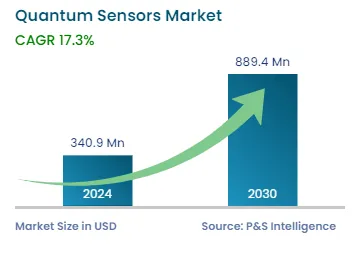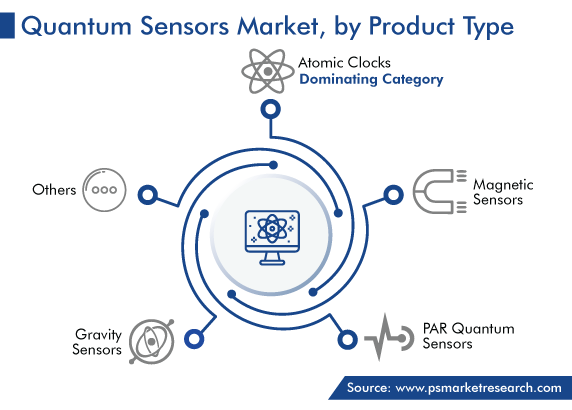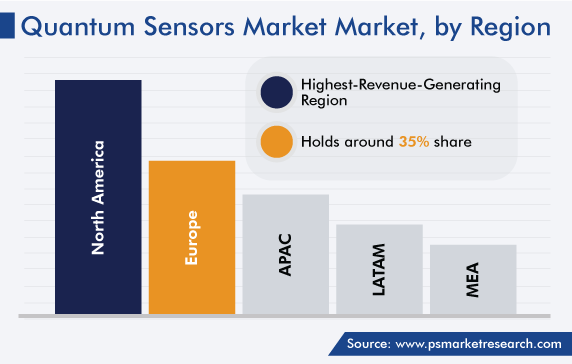Market Statistics
| Study Period | 2019 - 2030 |
| 2024 Market Size | USD 340.9 Million |
| 2030 Forecast | USD 889.4 Million |
| Growth Rate(CAGR) | 17.3% |
| Largest Region | North America |
| Fastest Growing Region | Asia-Pacific |
| Nature of the Market | Fragmented |
Report Code: 12664
Get a Comprehensive Overview of the Quantum Sensors Market Report Prepared by P&S Intelligence, Segmented by Product Type (Atomic Clocks, Magnetic Sensors, PAR Quantum Sensors, Gravity Sensors), Application (Military and Defense, Automotive, Oil and Gas, Healthcare), and Geographic Regions. This Report Provides Insights From 2019 to 2030.
| Study Period | 2019 - 2030 |
| 2024 Market Size | USD 340.9 Million |
| 2030 Forecast | USD 889.4 Million |
| Growth Rate(CAGR) | 17.3% |
| Largest Region | North America |
| Fastest Growing Region | Asia-Pacific |
| Nature of the Market | Fragmented |

Explore the market potential with our data-driven report
The quantum sensors market generated revenue of USD 340.9 million in 2024, which is predicted to reach USD 889.4 million by 2030, exhibiting a CAGR of 17.3% during 2024-2030. This is because of the extensive usage of these sensors to ‘re-build’ a wide range of industries and applications. Protons, neutrons, electrons, gluons, and quarks are used in the quantum mechanics concept. This sensor has a huge demand in the defense, healthcare, and aerospace sectors owing to its advantages over conventional technologies.
Moreover, their precise measurement and sensing capabilities are driving their usage on a large scale across industries. They can detect and measure atomic and subatomic particles, which enables improvements in controls, for instance, in computing, communications, and metrology. These instruments are critical components of quantum systems because they enable qubit readouts, quantum state detection, and quantum information processing. Hence, as quantum technologies advance, the demand for these devices is projected to skyrocket in tandem.
Furthermore, the defense and aerospace industry has made a prominent contribution to the expansion of the market, owing to the extensive utilization of these instruments in various applications, for instance, inertial navigation, gravity sensing, and magnetic field detection. These devices provide higher accuracy and stability, allowing for improved situational awareness and navigation in difficult conditions.
In addition, they are essential in areas such as medical imaging, diagnostics, and drug development in the healthcare business. Quantum sensing technologies allow for more-precise imaging modalities, such as magnetic resonance imaging (MRI), thus enabling early illness detection. Additionally, they are used in pharmaceutical research and development.
The technological advancements in quantum sensors are the key factor driving the growth of the market. This is because of the rising adoption of this technology in various industries, such as aerospace, defense, healthcare, and oil & gas. Additionally, as more research and development are conducted in the field of science and technology, a more-important role will be played by these sensors. They have the ability to provide better sensitivity and precision, which can be achieved by making use of quantum phenomena, such as entanglement and superposition. This makes it possible to gauge physical properties, such as magnetic fields, gravity, temperature, and electric fields, with greater accuracy and speed.
This is because modern sensors have seen a remarkable gain in sensitivity, accuracy, and precision than traditional ones. Medical diagnostics, environmental monitoring, and industrial process control are the areas where precise measurements are important and increased sensitivity has, thus, created a new opportunity.
The miniaturization of quantum sensors is another crucial technical advance. The developments in nanofabrication and other manufacturing methods have led to the creation of small, inexpensive devices, with a reduction in their size. This would be of immense benefit for , internet of things (IoT) and mobile platforms, due to the easy integration of these little sensors in compact consumer electronic products. The popularity of miniaturization has surged the applicability of these instruments in applications where mobility or available space are key considerations.
Furthermore, quantum technology capabilities have advanced so fast in recent years that it is now possible to interpret and analyze the high volumes of data produced by these devices. methods can easily resolve issues in data analysis, improve measurement precision, and offer quick insights.
The growing aerospace and defense industry around the world is the key driver for the advancement of the market. This is ascribed to the ability of this technology to detect and measure an extensive range of metrics, thus diagnosing problems that regular sensors might miss. Thus, there is a high demand for these instruments in the aerospace and defense industry for various devices and functionalities, such as navigation inertial sensing, gravitational wave detection, and magnetic anomaly detection.
Here, these instruments offer improved capabilities for target recognition, surveillance, and navigation. Some of the physical quantities that can be easily detected by these instruments are magnetic fields, gravity, and electromagnetic radiation, wherein even the minutest of changes can be identified and quantified.
Quantum sensors have the ability to transform navigation systems by offering more-precise and trustworthy positional data. They can go beyond the demerits of conventional technologies, which significantly rely on global navigation satellite systems (GNSS), which are susceptible to interference and jamming. Quantum gyroscopes and accelerometers have advanced navigation and inertial sensing capabilities, which can provide highly accurate rotation and acceleration data.
Quantum sensors are also useful for identifying magnetic fields that are inconsistent, because they can detect even a minor change in the direction and strength of the magnetic force. This becomes especially important when it comes to defense applications because they can locate submerged objects, including underwater mines and submarines. In addition, quantum magnetometers can offer better sensitivity and resolution compared to traditional magnetometers, which makes it easier to find and localize magnetic anomalies.
Another usage of these instruments in the industry is the identification of gravitational waves. The high frequency of astronomical events, such as the merging of black holes and neutron stars, can create gravitational waves, which are undulatory in the fabric of spacetime. Here, interferometric gravitational wave detectors offer high sensitivity and precision for detecting these minor signals, which can be helpful for space research missions and provide insightful information about astrophysical events.
Atomic Clocks Category Holds Largest Share
Based on product type, the atomic clocks category accounted for the largest share, of 40%, in the quantum sensors market in 2022, and it will further maintain its dominance in the future. This is owing to the exceptional accuracy of these instruments, advancements in technology, increasing demand for precise timing, and continuing research and development. These factors combine to make sure that atomic clocks cater to a wide range of industries and applications that depend on exact timekeeping and synchronization.
Moreover, the creation of smaller, more-easily transportable, and more-effective gadgets results from the improvements in the atomic clock technology. The usage of conventional atomic clocks has been limited to specific settings because of their size and complexity. Thus, the miniaturization of atomic clock components is important to boost their application in sectors with space and portability constraints. Mobile communications, self-driving cars, and aerospace systems are among the appropriate applications of modern atomic clocks, due to the latter’s mobility and flexibility.
Additionally, the rising investment in research and development projects centered on the atomic clock technology will help this category retain its dominance in the market. Atomic clocks are important for many industries, governments, academic institutions, and commercial businesses that are actively looking to increase their precision, stability, and durability. These continuous efforts will result in the emergence of more-sophisticated atomic clock designs with a better performance and reliability.

Drive strategic growth with comprehensive market analysis
Based on region, North America held the largest share in the quantum sensors market, of around 45%, in 2022, and it is further expected to maintain its dominance during the forecast period. This is ascribed to its strong technological infrastructure, high investment in research and development, presence of major end-use industries, and supportive government regulations in the region.
Moreover, North America gets the benefit of a strong network of industry players, which includes reputed companies and startups considering the adoption of quantum technologies. This network also encourages collaboration, knowledge sharing, and the development of cutting-edge quantum sensor solutions.
Additionally, North America has a favorable regulatory environment and government initiatives that promote the adoption of quantum technologies. Governments in the region recognize the transformative potential of this technology and, are thus, actively investing in research and development. These efforts are fueling partnerships between the academia and the industry and, ultimately, driving the market in North America.
Furthermore, the Europe region is likely to grow significantly in the market in the coming years. This is because of the rise in the production of electric vehicles in regional countries, especially Germany and the U.K., as sustainable mobility technologies are gaining tremendous popularity these days. The operation of batteries that are installed in electric vehicles can now be monitored with much greater accuracy with quantum sensors. As a result, electric vehicles can have a longer driving range, while still consuming less energy than before.
Moreover, by integrating these instruments, the battery of cars can be reduced by 10%, which will essentially lead to the reduction in the amount of energy required to operate these clean automobiles. The involvement of these sensors in vehicles will also lead to a decrease in carbon emissions, which is a key goal for countries around the world, especially those bound by the Paris Agreement and Kyoto Protocol.
Whereas, the Asia-Pacific (APAC) market is expected to grow at the highest pace over the forecast period, primarily because of the low manufacturing cost and surge in domestic and foreign investments in regional countries. China is making rapid progress by utilizing quantum sensors in machines that can perform complex calculations at a faster rate than before. Moreover, the People’s Republic has the potential to bypass the current encryption standards, using quantum sensors technologies, which would be a key driver for the market.

This report offers deep insights into the quantum sensors industry, with size estimation for 2019 to 2030, the major drivers, restraints, trends and opportunities, and competitor analysis.
Based on Product Type
Based on Application
Geographical Analysis
The quantum sensors market size stood at USD 340.9 million in 2024.
During 2024–2030, the growth rate of the quantum sensors market will be 17.3%.
Aerospace and defense is the largest application area in the quantum sensors market.
The major drivers of the quantum sensors market include the rapid development of quantum technologies, the persistent quest for technical breakthroughs, the surging use of these sensors to restructure a wide range of applications, and the rising demand for precise measurements and sensing capabilities across various sectors.
Want a report tailored exactly to your business need?
Request CustomizationLeading companies across industries trust us to deliver data-driven insights and innovative solutions for their most critical decisions. From data-driven strategies to actionable insights, we empower the decision-makers who shape industries and define the future. From Fortune 500 companies to innovative startups, we are proud to partner with organisations that drive progress in their industries.
Working with P&S Intelligence and their team was an absolute pleasure – their awareness of timelines and commitment to value greatly contributed to our project's success. Eagerly anticipating future collaborations.
McKinsey & Company
IndiaOur insights into the minutest levels of the markets, including the latest trends and competitive landscape, give you all the answers you need to take your business to new heights
We take a cautious approach to protecting your personal and confidential information. Trust is the strongest bond that connects us and our clients, and trust we build by complying with all international and domestic data protection and privacy laws
Customize the Report to Align with Your Business Objectives
Request the Free Sample Pages